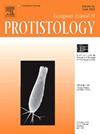The mitochondrial citrate synthase from Tetrahymena thermophila does not form an intermediate filament
IF 1.6
2区 生物学
Q4 MICROBIOLOGY
引用次数: 0
Abstract
The mitochondrial citrate synthase (mCS) purified from the ciliate Tetrahymena thermophila has been reported to form intermediate-filament-like structures during conjugation and to self-assemble into fibers when recombinantly expressed. This would represent a rare example of a tractable and recent origin of a novel cytoskeletal element. In an attempt to investigate the evolutionary emergence of this behavior, we re-investigated the ability of Tetrahymena’s mCS to form filaments in vivo. Using strep-tagged mCS in Tetrahymena and monoclonal antibodies, we found no evidence of filamentous structures during conjugation or starvation. Extensive biochemical characterization of mCS revealed that the self-assembly of recombinant protein is triggered by a specific chemical moiety shared by MES and HEPES buffers used in previous studies. The absence of indicative phenotypes in fiber-deficient GFP-tagged mutants indicates that Tetrahymena mCS did not evolve a structural role in sexual reproduction or metabolic regulation.
嗜热四膜虫的线粒体柠檬酸合成酶不形成中间丝。
据报道,从嗜热四膜虫(Tetrahymena thermophila)中纯化的线粒体柠檬酸合成酶(mCS)可在连接过程中形成类似中间膜的结构,并在重组表达时自组装成纤维。这代表了一种新型细胞骨架元素的可控和近期起源的罕见实例。为了研究这种行为在进化过程中的出现,我们重新研究了四膜虫的mCS在体内形成细丝的能力。利用链球菌标记的四膜虫 mCS 和单克隆抗体,我们发现在连接或饥饿过程中都没有丝状结构的迹象。对 mCS 进行广泛的生化鉴定后发现,重组蛋白的自组装是由先前研究中使用的 MES 和 HEPES 缓冲液共有的一种特定化学分子引发的。在纤维缺失的GFP标记突变体中没有出现指示性表型,这表明四膜虫mCS在有性生殖或新陈代谢调节中没有演化出结构性作用。
本文章由计算机程序翻译,如有差异,请以英文原文为准。
求助全文
约1分钟内获得全文
求助全文
来源期刊

European journal of protistology
生物-微生物学
CiteScore
4.60
自引率
20.70%
发文量
55
审稿时长
14.6 weeks
期刊介绍:
Articles deal with protists, unicellular organisms encountered free-living in various habitats or as parasites or used in basic research or applications. The European Journal of Protistology covers topics such as the structure and systematics of protists, their development, ecology, molecular biology and physiology. Beside publishing original articles the journal offers a forum for announcing scientific meetings. Reviews of recently published books are included as well. With its diversity of topics, the European Journal of Protistology is an essential source of information for every active protistologist and for biologists of various fields.
 求助内容:
求助内容: 应助结果提醒方式:
应助结果提醒方式:


